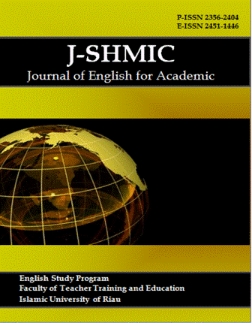Foreign Language Listening Anxiety in an Academic Listening Class
Keywords:
Listening, Anxiety, Foreign Language Listening Anxiety, Academic ListeningAbstract
In the process of teaching listening, anxiety is believed as a negative factor contributing to the students’ poor listening comprehension and quite possibly the affective factor that the most persistently hinders the learning process. Thus, investigating its existence and delving its factors become salient in order to help the students overcome their listening learning barriers. This present study attempts to depict the condition of the students’ listening anxiety in an Academic Listening (AL) class in an Indonesian tertiary context. 20-items of Foreign Language Listening Anxiety’s (hereafter, FLLA) questionnaire were administered to 97 students taking that course. Having finished analyzing the levels of students’ listening anxiety, in-depth interviews were conducted to four students who were considered having high listening anxiety to disclose the underlying factors. The research result revealed three pivotal issues; a) 54.6% of the students had a relatively high level of listening anxiety, 18.5% had moderate listening anxiety, and 26.8% had a low level of listening anxiety; b), 75% of the chosen measured items showed an extreme level of the students’ listening anxiety, and c) the major factor contributing the listening anxiety was inadequate listening proficiency involving the inability to deal with the rapid speech rate and range of lexical choices.
Downloads
References
Braun, V., & Clarke, V. (2012). Thematic analysis.
Christenberry, B. (2003). Listening comprehension in the foreign language classroom. Retrieved July, 23, 2013.
Dalman, R. M. (2016). The Relationship between listening anxiety, listening comprehension strategies, and listening performance among Iranian EFL university students. International Journal of Modern Language Teaching and Learning, 1(6), 241-252.
Elkhafaifi, H. (2005). Listening comprehension and anxiety in the Arabic language classroom. Modern Language Journal, 89(2), 206-220
Flowerdew, J., Long, M. H., & Richards, J. C. (Eds.). (1994). Academic listening: Research perspectives. Cambridge University Press.
Gilmore, A. (2007). Authentic materials and authenticity in foreign language learning. Language Teaching, 40, 97-118.
Goh, C. C. (2018). Metacognition in second language listening. The TESOL encyclopedia of English language teaching, 1-7.
Gonen, M. (2009, July). The relationship between FL listening anxiety and FL listening strategies: The case of Turkish EFL learners. In Proceedings of the 5th WSEAS/IASME International conference on educational technologies (pp. 44-49).
Hamouda, A. (2013). An investigation of listening comprehension problems encountered by Saudi students in the EL listening classroom. International Journal of Academic Research in Progressive Education and Development, 2(2), 113-155.
Kim, J. H. (2000). Foreign language listening anxiety: A study of Korean students learning English (Doctoral dissertation, University of Texas at Austin).
Lee, G. (2009). Speaking up: six Korean students’ oral participation in class discussions in US graduate seminars. English for Specific Purposes, 28, 142–156
Lili, C. U. I. (2015). Promoting the Development of Readers' English Listening and Speaking Abilities through Developing the Information Resources of the Art College Library. Sci-Tech Information Development & Economy, 2015(17), 33.
Lynch, T. (2011). Academic listening in the 21st century: Reviewing a decade of research. Journal of English for Academic Purposes, 10(2), 79-88.
Osada, N. (2004). Listening comprehension research: A brief review of the past thirty years. Dialogue, 3, 53-66.
Ito, Y. (2001). Effect of reduced forms on ESL learners' input-intake process. Second Language Studies, 20(1),99-124.
Tahsildar, M. N., & Yusoff, Z. S. (2014). Investigating L2 students’ listening anxiety: A survey at a Malaysian university. International Journal of Language Education and Applied Linguistics.
Pan, Y. (2016). Analysis of listening anxiety in EFL class. International Journal on Studies in English Language and Literature, 4(6), 12-16.
Vogely, A. J. (1998). Listening comprehension anxiety: Students‟ reported sources and solutions. Foreign Language Annals, 31(1), 67-80
Xu, F. (2008). Listening comprehension in EFL teaching. US-China Foreign Language, 6(1), 21-29.
Yang, R. L. (1992). A study of the communicative anxiety and self-esteem of Chinese students in relation to their oral and listening proficiency in English (Doctoral dissertation, University of Georgia).
Zhang, X. (2013). Foreign language listening anxiety and listening performance: Conceptualizations and causal relationships. System, 41(1), 164-177.
Published
How to Cite
Issue
Section
This is an open-access article distributed under the terms of the Creative Commons Attribution-ShareAlike 4.0 International License which permits unrestricted use, distribution, and reproduction in any medium. Users are allowed to read, download, copy, distribute, search, or link to full-text articles in this journal without asking by giving appropriate credit, providing a link to the license, and indicating if changes were made. All of the remixes, transform, or build upon the material must distribute the contributions under the same license as the original.











